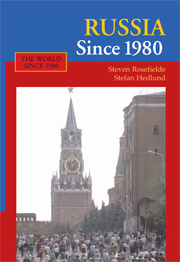Book contents
- Frontmatter
- Contents
- List of Figures, Tables, and Boxes
- Acronyms
- Timeline
- Preface
- Acknowledgments
- Introduction
- PART I RUSSIA BEFORE 1980
- PART II GORBACHEV
- PART III YELTSIN
- 6 Demolition and Systems Building
- 7 Crisis Management
- PART IV PUTIN
- PART V ADVANCE AND RETREAT
- PART VI PROSPECTS
- Conclusion
- Glossary
- Bibliography
- Index
- References
6 - Demolition and Systems Building
Published online by Cambridge University Press: 05 June 2012
- Frontmatter
- Contents
- List of Figures, Tables, and Boxes
- Acronyms
- Timeline
- Preface
- Acknowledgments
- Introduction
- PART I RUSSIA BEFORE 1980
- PART II GORBACHEV
- PART III YELTSIN
- 6 Demolition and Systems Building
- 7 Crisis Management
- PART IV PUTIN
- PART V ADVANCE AND RETREAT
- PART VI PROSPECTS
- Conclusion
- Glossary
- Bibliography
- Index
- References
Summary
Bonfire of the Privateers
The Soviet Union's death was startling. No one knew the fate that awaited. State-dependent workers, peasants, bureaucrats, administrators, red directors, communists, liberal democrats, and privateers were bewildered. Each placed its hopes on the government. Some couldn't believe that Boris Yeltsin intended to scuttle planning. Liberals expected the state to foster democratic free enterprise, while privateers considered the regime to be a partner in crime. As might be expected, the Yeltsin administration found it expedient to pose as all things to all people, while pursuing its own hidden agenda, namely, constructing a new Muscovite system based on the rule of men and enriching Yeltsin's family circle and crony servitors.
Box 6.1 Boris Yeltsin
Boris Nikolaievich Yeltsin, first president of the Russian Federation, was born February 1, 1931, in the village of Butka, Sverdlovsk Oblast, and died April 23, 2007. His grandfather was exiled for being a kulak, and his father spent three years in Gulag for anti-Soviet agitation in 1934–37. Boris was a construction major at the Ural Polytechnic Institute in Sverdlovsk, graduating at the start of Nikita Khrushchev's reign in 1955. He became the head of the Sverdlovsk House-Building Combine in 1965, joining the CPSU nomenklatura in 1968 at age thirty-seven, when he was appointed head of construction by the Sverdlovsk Regional Party Committee. In 1975, he became secretary of the Regional Committee on Industrial Development, and the next year, he was promoted to first secretary of the CPSU Committee of the Sverdlovsk Oblast, remaining in this powerful post until 1985, when Mikhail Gorbachev and Yegor Ligachev appointed him first secretary of the Moscow Communist Party Committee and a member of the Politburo. […]
- Type
- Chapter
- Information
- Russia Since 1980 , pp. 95 - 107Publisher: Cambridge University PressPrint publication year: 2008

